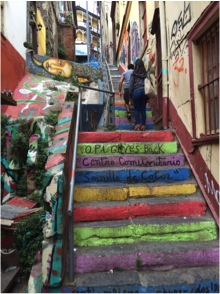We continue our series of blog posts from our Runstad Center Affiliate Fellows class of 2015, who recently traveled to Santiago, Chile, and Rio de Janeiro and Curitiba, Brazil. Here, Thaisa Way explores the important role of public spaces in social housing.
As a landscape and urban historian, I was thrilled to serve this year as a 2015 Runstad Affiliate Fellow. This trip to Chile and Brazil l has offered the opportunity to explore the design, use, and changes in public landscapes as integral contributors to the urban landscape. I have tried to pay close attention to the ways in which the public realm is fostered or challenged by the spatial character of public landscapes from the street to the plaza, from the park to the courtyard, from the front stoop to the park bench.
When discussing social housing in most cities, more often than not the focus is on the architecture of the building, perhaps the quality of construction, and the amenities of the living areas, from electricity to internet. What works and doesn’t work is evaluated within these parameters of analysis. However, if one visits social housing as we did in Santiago Chile, the role of the public realm becomes critically evident. The public realm of streets and sidewalks as out of door shared spaces are the common living areas for many in the community. They are where informal economies happen, where socializing is enjoyed, and where community is built, over time and space. The quality of the space determines whether the space fosters community or deters it- by offering safe spaces, by responding and meeting the needs of community members, and by offering diversity of experience.
They can often determine whether a community can come together. And yet it is this same space that is often of least interest to those developing social housing. In the community we visited, I was glad to see that at least some basic infrastructure was provided from curbed sidewalks to minimal set back at corners to allow for small gatherings. Small parks were also defined on the ground although the amenities were few. In downtown Santiago the infrastructure was more robust- with wide sidewalks, many plazas, and a fair number of public gardens and parks- almost every one with a playground for children carefully and thoughtfully integrated into the space. There is space for vendors and other public events to occur and on Sunday our last day, I had the delight to see many of the main boulevards shut down to cars and taken over by bicycle riders and runners of all ages. The houses and apartments in Chile are small for those in the lower income levels as well as the middle class – an important point being that Chile may be the first country in America to house 100% of its residents – thus the public realm is important – as space to breathe and space for community.
